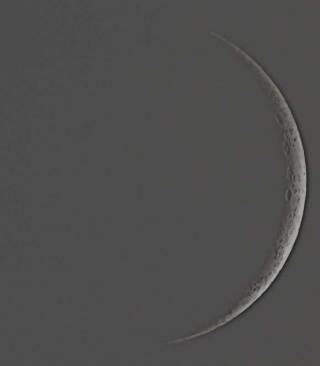Since the weather has gotten nicer after our record cold snap earlier in the month, I’ve been able to spend more of my evenings outside supervising the lad. It’s my favorite time of day: the chores are all done, the demands on my time are simple: just watch the lad as he cavorts on the sidewalk, jumps (well, that’s putting it charitably–he’s working on jumping) up and down on the deck, climbs up and slides down his little slide. But sometimes, as I’m outside with the boy, I happen to look up. Now and then it’s because he hears an airplane and swivels and points–sure enough, there goes someone headed for Boca Raton Airport. But every now and then, I just happen to look up out of curiosity.
And this weekend when I chanced to look up in the western sky, I saw the slimmest, youngest moon I think it’s possible to see. Here’s what I saw on Saturday night:
As you can see, I still need practice with my lunar photography; the image was pretty washed out, but thanks to the miracle of digital processing, it’s at least recognizable as an extremely slender waxing crescent moon. According to my ephemeris, the fraction illuminated at the time of the picture (6:20 p.m. EST on Saturday, January 16). The new moon was at 2:12 a.m. on Friday, January 15, so this image is about 40 hours after new moon (1 day, 16 hours, 7 minutes, according to my MoonPhase app). I’m sure it’s possible to see a younger moon, but I’ve never done so, as far as I know, and I certainly don’t have a picture of it!
So when I went outside on Sunday night, I glanced up to see if I could catch the second day of this lunation, and what do you know? There it was! With my inaccurate visual memory, I really couldn’t tell much difference in the size of the crescent moon; it was quite a bit higher in the sky than it had been on Saturday night, but it really didn’t look much bigger:
And it really wasn’t all that much bigger: .06 illuminated instead of .02. The moon was now 2 days, 19 hours, and 39 minutes old. I suppose that percentagewise it really was a lot bigger, and if I had the inclination to do the math I could even figure out how much more moon was visible and how much more light it reflected, but I’m not sure I want to do that.
Just a quick comparison of the photographs shows how unreliable visual memory is. In the first photo, I would be hard pressed to identify one single feature. Maybe, if you put my back to the wall and a gun to my head (and why, pray tell, would you want to do that?) I might speculate that the Mare Crisium is perhaps showing its easternmost edge in this photo, but if you wanted to tell me different, I’d believe you (particularly since you’ve backed me up against a wall and threatened me with violence).
In the second photo, though, it’s fairly easy to make out a large portion of Mare Crisium on the lower right; moving up from there you encounter 4 fairly distinctive craters:
- Langrenus, a deep crater 132 km in diameter; it has a dark interior in this photo because the sun hasn’t risen high enough to illuminate the floor.
- Vendelinus, 147 km in diameter; it looks a bit deformed in this image because another crater, Lame (or Lamé as it’s properly called), intersects part of its ring.
- Petavius, 177 km in diameter; its central mountain chain catches the light quite strikingly even in this crummy photo.
- Furnerius, another crater with a dark floor in this low light; 125 km in diameter. Notice how this crater’s ring is not as brightly lit as Langrenus’s; is that because the “mountains” forming that ring are not as high, so they don’t catch as much light? In the drawings, the ring looks significantly more eroded, and quite a bit thinner, than Langrenus’s…
My Rükl atlas comments on this string of four prominent “young moon” craters:
Furnerius is part of a fine chain of craters with Langrenus, Vendelinus and Petavius.
Rükl certainly has the right of this, but only as far as he goes. I would add that not only is this a particularly fine chain of craters, but identifying them is practically the only way to get one’s bearings on such a young moon!




2 thoughts on “January moons, days one and two”